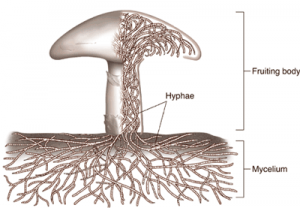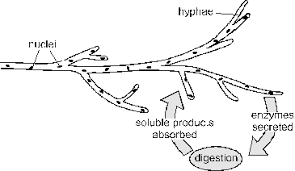A cruel side of independence is mold; we barely remembered it existed and now it’s in places we didn’t even know we had to clean. But fungi can also clean what we leave lying around. This is an underrated story about fungi and how they can restore ecosystems in former mines.
Mineral exploitation leaves many problems behind. These places suffer from soil alkalinity and are deficient in minerals that support life. They are “inhospitable environment with huge loss of soil and water, vegetation recession, rock bareness, and productivity loss” as reads the research article by Yawen Wu and others about the fungal strain Gongronella sp (of the Cunninghamellaceae family of fungi) and its role in restoring soil and life after rock mining.
But how can fungi solve this problem? The team researched how fungi could improve the process of external-soil spray seeding. The technique consists in spraying plant nutrients and seeds to restore vegetation. However, it tends to fail because the soil layers in abandoned mines are very thin; this is where the Gongronella comes in.
The fungi can, in theory, do two things the spray can’t: degrade rocks to make the soil lining thicker and release organic material from as deep as 12mm from the surface.
To undestand this, we need to think about how some fungi eat and grow. Some fungi grow in net-like structures called mycelia which are composed of structures called hyphae. These fungal ramifications grow towards food sources and mold to them, so they can access creases and shapes of the mine rocks. The fungus eats by digesting whatever materials it finds around the hyphae and absorbing some of it so some of the digested organic material would remain available in the mine’s ground.

Parrts of a fungus (https://moodle.clsd.k12.pa.us/district_videos/Biology/iText/products/0-13-115540-7/ch21/ch21_s1_2.html)

Fungi secrets enzymes that digest compounds neat it and then uptakes the digestted products (http://www.biologymad.com/master.html?http://www.biologymad.com/digestion/digestion.htm)

The team isolated Gongronella sp fungi from a rock mine and cultured them in the presence of rock samples. They used analytical chemistry techniques to monitor the presence of organic acids, monitored the pH as the cultures grew, measured the general loss of mass in the rocks and tracked the appearance of minerals that are necessary for plant growth like Mg2+ and Ca2+.
As expected, the team found a decrease in pH and increase in Ca and Mg from the rocks as the fungi grew. The rocks degraded into small soil particles very quickly and they observed how the mycelium helped these results happen. Furthermore, the organic acids (citric acid, succinic acid and others) that resulted from the fungi digesting the rocks have the advantage for plant life too. They provide grounds for coordination complexes which are widely used by plants and much better compared to the inorganic acids that would result from neutralizing the mine’s pH with industrial inorganic chemicals.
The Gongronella seems to be mostly useful in rocky mines but other fungal strains like Penicillium or Mucor have been found useful for metal mines. As much as we hate mold in bread, fungi prove to be fascinating and may really have our back someday, so stay weird fungi and thank you.

-Isabella Correa
